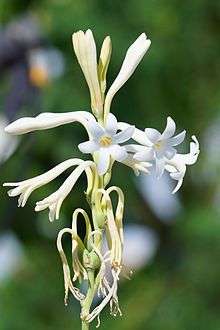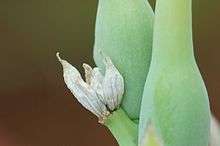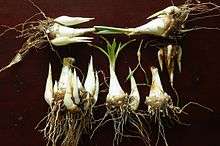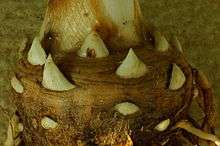Polianthes tuberosa
| Tuberose | |
|---|---|
 | |
| Scientific classification | |
| Kingdom: | Plantae |
| Clade: | Angiosperms |
| Clade: | Monocots |
| Order: | Asparagales |
| Family: | Asparagaceae |
| Subfamily: | Agavoideae |
| Genus: | Polianthes |
| Species: | P. tuberosa |
| Binomial name | |
| Polianthes tuberosa | |
| Synonyms[1] | |
|
List
| |
Polianthes tuberosa, the tuberose, is a perennial plant related to the agaves, extracts of which are used as a note in perfumery.
Etymology
The common name derives from the Latin tuberosa through French tubereuse,[2] meaning swollen or tuberous in reference to its root system. Polianthes means "many flowers" in Greek.
Other languages
In Spanish, the flower is called nardo or vara de San José, which means "St. Joseph’s staff".. It is called kupaloke in Hawaiian.[3] In Nahuatl it is called omixochitl "bone flower".[4] In the Philippines, the plant is also known as azucena.. In Indonesia, the plant is known as 'bunga sedap malam' (lit. Flower that smells good in the night) In Hindi tuberose is known 'Nishigandha'. In Iran, it is known as 'Maryam', named after the Virgin Mary.In Bangladesh it is known as Rajnigandha (the flower which smells at night )
Description
The tuberose is a night-blooming plant native to Mexico, as is every other known species of Polianthes.[5] It grows in elongated spikes up to 45 cm (18 in) long that produce clusters of fragrant waxy white flowers that bloom from the bottom towards the top of the spike. It has long, bright green leaves clustered at the base of the plant and smaller, clasping leaves along the stem. Epiphyllous adhesion of stamens is seen in the flower.[6] In India and Bangladesh they are widely used in making flower garlands which are offered to the gods or used as wedding ornaments.
Members of the closely related genus Manfreda are often called "tuberoses". While once associated with funerals, it is now used in floral arrangements for other occasions.[7]
In Indonesia, tuberose flowers are also used in cooking.[8]
In Perfumery
The overwhelming fragrance of Polianthes tuberosa has been distilled for use in perfumery since the 17th century, when the flower was first transported to Europe. French Queen Marie Antoinette used a perfume called Sillage de la Reine, also called Parfum de Trianon, containing tuberose, orange blossom, sandalwood, jasmine, iris and cedar.[9][10] It remains a popular floral note for perfumes, either in stand-alone Tuberose fragrances or mixed floral scents, but it generally must be used in moderation because the essence is overpowering and can become sickly to the wearer.[11]
Cultivation

Tuberose can be grown outdoors in hardiness zones 8-10, where they will survive in-ground if the temperatures don't drop any lower than 20° Fahrenheit.[12] In colder zones Tuberoses are grown as summer annuals, in pots or mixed-flower borders where they can be enjoyed for their scent. To flower the plants require around 4 months of warm temperatures from the time the rhizome is planted. Gardeners usually start the rhizomes in pots in greenhouses beginning in late-winter or early spring, moving them outdoors in late spring once frost danger has passed.[13] If they are started directly in the ground at this time, they may not bloom until September, greatly reducing the period in which their blooms may be enjoyed. Once the foliage begins to yellow in October, the leaves should be clipped,the rhizomes dug and stored in a cool, dry and dark place for the winter.[14] The most popular variety is a double-flowering cultivar known as 'The Pearl' that grows to 2.5 feet tall and features pale pink buds opening to cream.[15] The more common variety is called 'Mexican Single', which, although not as flashy as 'the Pearl', makes for a longer lasting cut flower.[16]
Tuberoses were especially beloved by Louis XIV of France, who had them planted in the hundreds in the flower beds of the Grand Trianon at Versailles so that the scent was overpowering. They were grown in clay pots and planted directly in the ground; to keep the perfume consistently strong new specimens were rotated in, sometimes daily.[17]


Gallery
 Polianthes tuberosa buds
Polianthes tuberosa buds top view of tuberose buds before blooming
top view of tuberose buds before blooming this is the night view of the flower
this is the night view of the flower the plant's condition after about 3 weeks.
the plant's condition after about 3 weeks.
References
- ↑ "The Plant List: A Working List of All Plant Species". Retrieved March 4, 2014.
- ↑ Wedgwood, Hensleigh (1855). "On False Etymologies". Transactions of the Philological Society (6): 66.
- ↑ Choy, Duane (2011-05-09). "Tuberose has abundance of dazzling fragrance". Honolulu Star-Advertiser. Star Advertiser. Archived from the original on 2015-12-07. Retrieved 2015-12-07.
- ↑ Cook, Suzanne (15 March 2016). The Forest of the Lacandon Maya: An Ethnobotanical Guide. Springer. p. 111. ISBN 978-1-4614-9111-8.
- ↑ "World Checklist of Selected Plant Families: Royal Botanic Gardens, Kew". apps.kew.org. Retrieved 2016-08-23.
- ↑ Morphology of Flowering Plants, Higher Biology, Dulal Chandra Santra
- ↑ Trujillo, E. E. (1968). Diseases of Tuberose in Hawaii (PDF) (Cooperative Extension Service Circular 427 ed.). Honolulu: University of Hawaii. p. 13. Retrieved 10 October 2015.
- ↑ Amit Baran Sharangi; Suchand Datta (27 February 2015). "5.3.6: Tuberose". Value Addition of Horticultural Crops: Recent Trends and Future Directions. Springer. p. 96. ISBN 978-81-322-2262-0. Retrieved 17 December 2017.
- ↑ Chant Wagner (2007-01-07). "M.A. Sillage de la Reine by Chateau de Versailles". MimiFroufrou.com.
- ↑ Saskia Wilson-Brown (2015-06-26). [blogs.getty.edu/iris/froth-and-folly-nobility-and-perfumery-at-the-court-of-versailles/ "Froth and Folly: Nobility and Perfumery at the Court of Versailles"] Check
|url=value (help). blogs.getty.edu. Retrieved 2018-03-26. - ↑ Marianne Mychaskiw (2017-10-13). "This Floral Note Is So Sexy, It Was Banned in the Victorian Era". InStyle Magazine. Retrieved 2018-03-26.
- ↑ Brent and Becky's Bulbs Archived 2013-06-16 at Archive.is
- ↑ Kathleen Norris Brenzel (2007). Sunset Western Garden Book. p. 555.
- ↑ Kathleen Norris Brenzel (2007). Sunset Western Garden Book. p. 555.
- ↑ "The Pearl Tuberose". Burpee Seeds. Retrieved 2018-01-30.
- ↑ Kathleen Norris Brenzel (2007). Sunset Western Garden Book. p. 555.
- ↑ Tony Spawforth (2008). Versailles: A Biography of a Palace. p. 15.
External links
